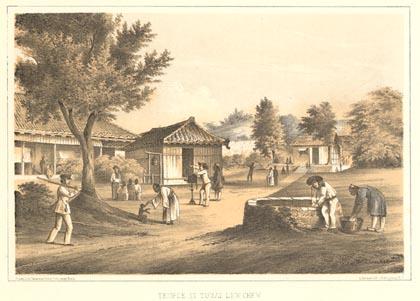Also, "Kata Guruma," page 112-113 of Kyuzo Mifune, The Canon of Judo: Classic Teachings on Principles and Techniques, Kodansha, 2004.
Also, "Kata Guruma," page 157-164 of Tadao Otaki and Donn DraegerJudo Formal Techniques: A Complete Guide to Kodokan Randori No Kata, Tuttle, 1983.
Also, "Kata Guruma," page 141 of M. Nakayama, Best Karate: Jitte, Hangetsu, Empi, Kodansha, 1981.
Step 34-36 begins with a gedan barai in backstance (step 34), followed by a two-handed grasping gesture in side stance (step 35), and the famous 360-degree turning jump (step 36).
The first move of the cluster, step 34, is performed as a downblock in back stance in modern Shotokan, but it was not always so. The very earliest films of Shotokan students doing Empi show them performing a "swallow block" at this point in the kata, just like we do in step 8. Modern Shito Ryu performers still do the kata this way. See the "perspective article" for more information.
By our earlier analysis, the "swallow block" is probably a tai otoshi throw. This throw is easily thwarted if the opponent has the presence of mind to simply step across your extended leg with his right foot. If he attempts this counter, you have to shift to a different throw. The kata garuma (shoulder wheel) is the perfect throw to apply in this circumstance.
Nearly everyone in this field agrees that step 35 is the setup for kata garuma, partly because Master Nakayama showed that application in volume 7 of his Best Karate series in 1981. He got the details wrong, claiming to use the left hand to grasp the opponent's jaw instead of his arm, but the general idea was correct. Many Shotokan teachers think this is the only throw in the kata, which is a pity.
Face your partner in fighting stance, both with the right foot forward. Without stepping, he throws a right roundhouse punch toward your face. You block the punch with your left upblock and catch his wrist. Step in deeply with your right foot to set up the tai otoshi throw, as described for Empi, step 8.
At this point your opponent resists by lifting his right foot and stepping over your extended leg. This makes it impossible to complete the tai otoshi attack. At this point the opponent has his left foot forward, and your right leg is already between his legs. You have a firm grip on his right wrist, held in upblock position next to or above your head.
In step 35, you shift toward the opponent in side stance. Duck under his arm so you can draw him across your shoulders. Your right arm hooks under his right thigh, catching his leg in the bend of your elbow. Straighten your back and legs to lift him off the ground. (This position is widely known as "the fireman's carry.") Here's an illustration from http://www.judosport.net.
The normal dismount would be to "dump" him head-first off your left shoulder. Note that surviving this fall requires thick mats and good falling skills, both of which are rare in karate classes. Don't let your students get into trouble here.
The jump in step 36 can be explained three ways. You have just dumped a body on the floor, so you may be jumping over it. According to Iain Abernethy, you are jumping on the body. Alternately, Iain also says that you may be dumping the enemy down a well. In that case, I guess, you are jumping across the well to put it between you and your remaining enemies. This forces the enemies to choose between chasing you and rescuing their drowning colleague, which is a good tactical move.
This is the kind of open well we are talking about, from the Perry expedition to Okinawa in 1852:


